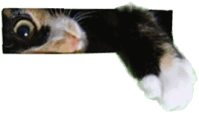Cat aggression - "pat my back, feel my claw"

Thousands of people are bitten by their cats every year. Although, statistically speaking, people are much less likely to be bitten by a pet cat than a pet dog (actually 6 times less likely), cat bites carry their own dangers. Bites often become infected, even those which look quite innocuous at first. Likewise, you underestimate a cat's claws at your peril. They are very sharp and even a light scratch will draw blood. A deep scratch might require stitches. It is not surprising that we fear being scratched or bitten by this formidable arsenal.
Epidemiological research carried out in the United Stats showed that most bites and scratches are on owner's hands and arms and happen when the owner pets his cat. The same research also showed that these injuries could be classified as 'provoked'. (For a given value of 'provoked') Most owners would indignantly argue that was absolutely no provocation prior to the cat turning savage. They just love to cuddle and pet their furry friend and end up being clawed by the ungrateful creature. A friend of mine once told me about her cat which would come to be petted and after a while would suddenly turn and lash out at her face. It is common for vets and doctors to hear reports that the attack 'came completely out of the blue'. But it is important to understand that even if we didn't do anything wrong or different, the cat could still have been 'provoked'. We just have to remember that cats are not little humans in furry jumper suits, but creatures with a totally different perspective on the world.
The simple truth seems to be that most cats do not like to be petted for as long as their humans want to pet them. Indeed the owner has done nothing wrong or different. The problem is that after a while the pleasurable sensation of being petted turns by itself into something unpleasant for the cat. Watching cats grooming each other gives an idea of what's wrong. Cats groom each other only briefly, seldom even for as long as a few minutes. The sessions are ended by one of the cats walking away. It's less easy if the cat is firmly clamped in its human's loving embrace.
When a cat becomes tired of petting it will become restless. Look for a twitching tail, the ducking of the head away from the petting hand, or even grinding teeth or fake biting motions. These warnings are clear indications that the cat has had enough affection for now. If you ignore the signs, the cat may proceed to end the session by other means. Some cats may simply jump off your lap and walk away. My cat, for example, makes it plain when she is feeling independent. At those times, if I try stroking her, she will just lower her back into a sort of feline press-up to avoid my hand. She has never shown aggression towards us, but then she never needed to, because with the first sign of her moving away, we leave her alone. We are lucky in that her way of showing discomfort is very easy to interpret. Other cats may be more passive, they are comfortable on the owner's lap and do not necessarily want to move from a warm spot, but at the same time do not want to be petted any more. If the petting persists they may turn and bite or scratch. This is true even when the cat comes and initially seeks affection.
Watching for warning signs and limit petting time, and you will have done a lot to prevent this type of aggression. If the cat seems somewhat restless, stop petting immediately. If there seem to be no warning signs, limit the petting to brief intervals, literally few pats at a time. If the cat bites even after a short session, cease petting completely and proceed to ignore the cat for a while. Wait for the cat to initiate affection, but keep petting brief, and watch for any signs of irritation. Many cats become desensitized and learn to tolerate, or even enjoy long petting sessions.
It may be counter-intuitive, but never physically punish the cat for biting or scratching you on these occasions. Punishment works for socially orientated animals - which cats are not. A cat simply does not understand the concept of punishment, and will simply come to think of petting sessions as something that ends in violence. And hitting the cat at the time when she is already feeling aggressive is likely to cause retaliation, and you could find yourself in a catfight in which the other side has you seriously outgunned. The second important thing is that you should never ignore any form of aggression. Start treating it as soon as the first signs appear. Cats are conservative creatures who like habit and routine; if you let the cat think that biting and scratching is normal, acceptable, behavior then attacking you might literally become routine.

